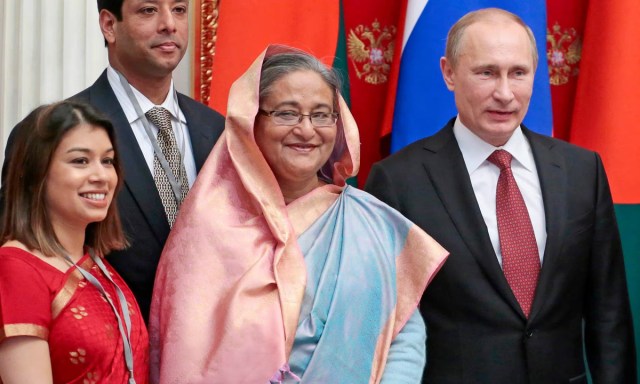‘Where should the money end up but in bent Britain?’ Mikhail Metzel/Pool/AP.

You can have a bodyguard spy on your wayward wife, Juvenal says in his Satires, but there’s always the possibility that she sleeps with the bodyguard himself. “Quis custodiet ipsos custodes?” he ruefully observes, “who will guard the guards themselves?” It’s a question that evidently wasn’t on Sir Keir’s mind when he appointed Tulip Siddiq as City minister. Her brief was financial crime — being tough on it, that is. It turns out there may have been some confusion on that front.
Siddiq was born into a large connection of power and property. Her family has been dubbed the Kennedys of Bangladesh. Her aunt, Sheikh Hasina, ruled Dhaka from 2009 to 2024 more or less as a dictator. And like most aunts, she was given to materteral largesse. To begin with, there was the electoral meddling. Her party, the Awami League, apparently helped her niece on the hustings in 2015; “Had it not been for your help,” Siddiq said to an Awami crowd on her election as MP for Hampstead and Highgate, “I would never have been able to stand here as a British MP.”
Then there were the houses. Rather in the manner that bird droppings fall on unlucky souls, properties would seem to have lashed down on Siddiq and her family. First came a pied-à-terre in King’s Cross, bequeathed by a developer, an Awami man, in 2004. When prying hacks had the temerity to inquire into the ownership of the flat in 2022, Siddiq threatened them with lawsuits, asseverating that the property was a gift from her parents. Thereafter, were two Hampstead flats, both owned by Awami figures. Another party man owns her current East Finchley digs, a semi-detached dwelling worth £2 million. A billionaire advisor of Hasina’s, meanwhile, owns Siddiq’s mother’s Golders Green house through an offshore trust.
Publicly, Siddiq has let on that a vile press, pandering to popular prejudice, has made much ado about what are blood ties and no more: “Are you aware that I am a British MP and that I’m born in London?” But there was that little faux pas on her part, when she accompanied her aunt to the Kremlin in 2015, shaking hands with Putin as the two leaders inked an arms and nuclear energy deal. Siddiq, however, maintains she was only there to spend “time with her family”. Oh.
Since Hasina’s government was toppled by students in August 2024, we have seen a drip feed of accusations from Bangladesh’s Anti-Corruption Commission — one of which sealed Siddiq’s fate on 14 January. Quite apart from lodging at Awami houses on both sides of the Heath, Siddiq was allegedly involved in the allocation of a plot of land in Dhaka’s diplomatic zone to her mother. She announced her resignation on the same day.
But the Tulip Siddiq affair, of course, is only the tip of the iceberg. The bigger story is Hasina’s kleptocratic regime and Britain’s role as its handmaiden. Dhaka’s court has now revealed that the price tag of the Rooppur nuclear power plant, being built for the Bangladeshis by Russia’s state-owned nuclear company Rosatom, was inflated by $5 billion — allegedly misappropriated by the Hasina family and its cronies.
And where should the money end up but in bent Britain? Hasina’s ministers and oligarchs, the Observer has revealed, own British real estate worth almost £400 million. They include the tycoon Salman Rahman, who runs the vast Beximco conglomerate, which, among other contracts, was handed over the national monopoly to distribute the Oxford/AstraZeneca vaccine. Rahman and his family own seven apartments in Mayfair through shell companies. Apparently a career politician, Hasina’s land minister Saifuzzaman Chowdhury meanwhile owns hundreds of properties in Britain, with a combined worth north of £160 million. Then we have the Sobhan family, real estate magnates who couldn’t repay state loans, yet somehow managed to purchase a £10 million Kensington mansion.
Hasina’s kith and kin are accused of benefitting from “plain robbery”, in the words of Muhammad Yunus, Nobel laureate and now Bangladesh’s stopgap ruler. They have waged, as it were, a two-front class war against Bangladeshi taxpayers and British renters. And in this endeavour, they have been aided by Butler Britain: estate agents, private banks, law firms, and indeed lawmakers, who have developed a Swiss-cheese style compliance regime, whose very edifice was designed to allow the Rahmans and Chowdhurys, Abramovichs and Kulibayevs, to squirrel away their riches in this island. The loopholes are the system. This is why Siddiq had to go. She is alleged to be benefitting from the very world she was meant to oversee.
And a grim world it was. Auntie Hasina’s wealth and power were built on an empire of violence and malversation. But things didn’t start out that way. Indeed, for a long while, she was the great hope of democracy in a land eternally cleaving to khaki rule. Her father was the country’s founding father, Sheikh Mujibur Rahman. Bangladesh, it will be remembered, was once “East Pakistan”, part of the cartographic oddity sandwiching India ruled first from Karachi, then Rawalpindi, and finally Islamabad — all in “West Pakistan”, which was hegemonic culturally, economically, and militarily. In 1970, Rahman won the election. Stinging from the humiliating prospect of having to salaam an “effete” Bangla ruler for the following five years, Pakistan’s generals promptly unleashed a genocide. Over the following months, three million were killed. India, sensing an opportunity, invaded the country. Pakistan’s army was sent packing, and Rahman declared independence.
Four years later, it was another set of generals who came to cause grief to Rahman. Perceived as too much of a leftie, with his unhealthy penchant for redistribution and nationalisation, he was massacred, along with the rest of his family, by army personnel in a Scarface-style mansion shootout in 1975. The very Bangladeshi coup brought to power a military junta.
As it was, Hasina emerged unscathed from the violent contraction of the Rahman ménage, thanks to a European holiday. Six years later, she emerged from Indian exile to take charge of the Awami League. In that role, she fashioned a reputation as a level-headed democrat, opposed to both General Ershad’s military dictatorship as well as her father’s socialist zeal.
From this cautious start, for which she garnered global sympathy, Hasina grew into one of the most unprepossessing politicians of our age. It is a trajectory South Asians wearily recognise; Aung San Suu Kyi, another nepo baby, similarly went from being the toast of the free world to a toasted pariah. Hasina’s autocratic turn owed much to the “battle of the begums” that played out around the turn of the century — a dialectic of violence and corruption that sustained the competition for the top job between two well-heeled women, Hasina and her rival, the Bangladesh National Party’s Begum Khaleda Zia. Hasina won out. Zia was put under house arrest, and her son exiled.
Following her victory in the 2009 election, the country’s last free and fair one, Hasina set about belligerently consolidating power. Elections became farces boycotted by the main opposition party, and kangaroo courts mushroomed. The police acquired a taste for torture, for pulling nails and hanging prisoners. Her detractors and dissidents developed the uncanny ability to simply disappear.
The economy ostensibly did well. Bangladesh achieved a 203% per capita increase in GDP in the last quarter-century, on a par with peer nations — India (216%) and Vietnam (244%) — and leagues ahead of the land from which it seceded, Pakistan (44%). This owed in great measure to the roaring success of the garment industry, profiting a wafer-thin entrepreneurial class that scarcely paid anything in taxes — the top rate is 25p — and concealing Hasina’s cataclysmic handling of state finances: soaring debt; eye-watering inflation; depleting reserves. Serious public investment is scarcely possible under such constraints. At any rate, a tidy chunk of the budget under Hasina vanished into the hands of its trigger-happy army.
Keeping the generals happy exacted a toll. Having to perennially whip out her begging bowl before Delhi and Beijing, Hasina proved singularly incapable of crafting an independent foreign policy. Indeed, her critics with some justice described her as Delhi’s creature. The crumbs the Indians threw her way were repaid through accommodating water-sharing arrangements and market access — another big market, given recent figures put the Bangla population at 173 million. Delhi sweetened the pill by helping cool tempers in DC, where periodic excoriation of the human rights abuses of other nations is very much the norm. Antony Blinken, the US secretary of state, was responding to Indian pressure when he instructed his ambassador to Dhaka and the assistant secretary of state for South and Central Asian affairs to “knock it off with Bangladesh”.
In the end, Hasina’s cronyism and brutality proved her undoing. The straw that broke the camel’s back was a nakedly clientelistic job scheme — three in 10 government jobs were to be reserved for the heirs of the “veterans” who fought for the country’s liberation in 1971, which is to say for legacy Awami Leaguers. The upshot was last summer’s Monsoon Revolution. The state’s tyrannical security apparatus met its match in the idealistic bright young things amassing on Dhaka’s streets.
Hasina went down kicking and screaming. More than 1,500 protestors were killed, and 20,000 injured. But the students kept at it until Hasina was forced to flee to India on a chopper. The 84-year-old microfinancier Muhammad Yunus, who had for long been a thorn in Hasina’s side, was dragged to Dhaka from his Paris hospital by students and installed as interim leader in August. And so the curtain fell on autocratic misrule.
Hasina’s successors, it must be said, did not put their best face forward on seizing power. Awami Leaguers were massacred wholesale in retaliatory violence; the country’s Hindu minority, too, bore the brunt, not least because Hasina had cultivated a reputation as an Indophilic anti-Islamist. Indeed, the Islamist Jamaat-e-Islami party, once mercilessly suppressed by Hasina, has renewed its shariatic hopes; there is even talk of a Bangla caliphate.
But hope springs eternal. Hasina’s fall and now Siddiq’s are reasons for optimism. Tying up the loose ends, in metropole and former colony alike, will of course prove harder. The billionaire Banglagarchs are nothing if not powerful; Butler Britain, nothing if not efficacious. Both Dhaka and London have their work cut out.









